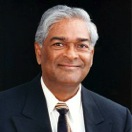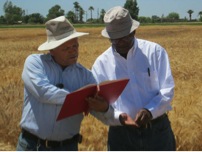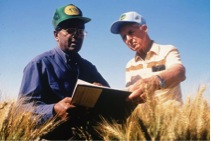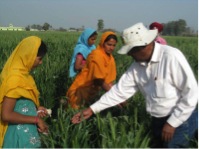
The eminent plant scientist Dr Sanjaya Rajaram, born in India and a citizen of Mexico, will be honored as the 2014 World Food Prize Laureate for his scientific research that led to a prodigious increase in world wheat production – by more than 200 million tons – building upon the successes of the Green Revolution.
His breakthrough breeding technologies have had a far-reaching and significant impact in providing more nutritious food around the globe and alleviating world hunger. Dr Rajaram succeeded Dr Norman Borlaug in leading CIMMYT's wheat breeding program, and developed an astounding 480 wheat varieties that have been released in 51 countries on six continents and have been widely adopted by small- and large-scale farmers alike.
Statement of Achievement
As the World Food Prize celebrates the centennial year of his mentor, Dr Norman Borlaug, as well as the UN-FAO’s International Year of Family Farming, it is especially fitting that we recognise the achievements of Dr Sanjaya Rajaram, which have benefitted farmers and consumers worldwide. Dr Rajaram’s crossing of winter and spring wheat varieties, which were distinct gene pools that had been isolated from one another for hundreds of years, led to his development of plants that have higher yields and dependability under a wide range of environments around the world.

Dr Rajaram evaluating wheat in Mexico
Early Life and Education
Sanjaya Rajaram was born in 1943 near a small farming village in the state of Uttar Pradesh in northeastern India, four years before the country won its independence from Britain. His family, including his parents, an older brother and a younger sister, made a meager living on their five-hectare farm growing wheat, rice and maize. Recognising that, at an early age, Sanjaya was keenly interested in learning about the world around him, his parents sent him to primary and secondary schools in a village five kilometers away from his home. This was at a time when roughly 96% of the rural population had no formal education.
He was a successful student, rising to first place in his primary and secondary schools. He eventually became the top-ranked student in the entire Varanasi District, which included thousands of village and city schools. He won a state scholarship to attend high school, and from there he went to the College of Jaunpur at the University of Gorakhpur, earning a BS in agriculture in 1962. He next studied genetics and plant breeding under Dr MS Swaminathan at the Indian Agricultural Research Institute in New Delhi, graduating with his master’s degree in 1964.
The following year he went to Australia where he studied for his PhD in plant breeding at the University of Sydney on a scholarship from the Rotary Club of Narrabri. His professor and mentor at the university was Dr IA Watson, who had been a fellow graduate student with Norman Borlaug under Dr EC Stakman at the University of Minnesota. Watson recommended him to Dr Borlaug and Dr Glenn Anderson at the International Maize and Wheat Improvement Center (CIMMYT) in Mexico – and this set in motion Rajaram’s distinguished scientific career in wheat research.
Having grown up in a small village where people had very little, Rajaram knew he wanted to conduct plant research, through which he could directly effect change and make a difference in food production. In this regard, Rajaram agreed with Borlaug concerning the importance of hands-on field research, the application of science and the practical approach to achieving results.
Working with Borlau
Rajaram’s research and field work began at CIMMYT in 1969, as he worked side by side with Borlaug in the experimental fields of El Batán, Toluca and Ciudad Obregón. In 1972, Borlaug asked Rajaram to succeed him and head up the wheat breeding team at CIMMYT. Rajaram has said that the following year was a learning phase during which he came to realise the diversity in wheat and began experimenting with cross breeding winter and spring wheat varieties.
Rajaram implemented a major expansion of Borlaug’s ingenious shuttle-breeding approach in countries beyond Mexico, emphasising wide adaptation of new plants to differing climate and soil conditions, superior grain quality, and increasing the resistance to diseases and pests that had devastated farmers’ crops. This shuttle breeding technique involved growing two successive plantings each year in northern and southern latitudes, which produced two test generations of wheat each year instead of one, cutting in half the years required for research and breeding new varieties. The variation in climatic conditions also resulted in wheat plants that were broadly adaptable to varying temperatures, altitudes and soil types.

Dr Rajaram and Dr Borlaug working in wheat fields in Mexico
Innovation in Wheat Breeding
Rajaram significantly advanced his mentor’s work in improving wheat varieties during a period that has been described as the “golden years” of wheat breeding and production. Like Borlaug, Rajaram had the extraordinary ability to visually identify and select for cross breeding the plant varieties possessing a range of desired characteristics, an ability that was essential to wheat breeding in the 1980s and ‘90s. The yield potential of Rajaram’s new cultivars increased 20 to 25%. Grown on more than 58 million hectares worldwide, Rajaram’s high-yielding wheat varieties are disease- and stress-resistant and adaptable to diverse geographical regions and climate conditions. The importance of this work cannot be underscored enough, as wheat is a staple food and a key source of calories and protein for billions of people.
In addition to increasing the world’s production of wheat, Rajaram’s new varieties reached into marginal areas, such as small mountain plots in Pakistan and remote areas in China. An important contribution was his development of aluminum-tolerant wheat that was able to grow successfully in the acidic soils of Brazil. Additionally, he foresaw diseases that had the potential to threaten crops on a world scale, and he and his CIMMYT team introduced resistance into modern wheat varieties to protect the food supply.
Rajaram also developed wheat cultivars with durable resistance to rusts ̶ the most damaging disease to wheat worldwide ̶ through his concept of “slow rusting.” He used multiple genes with minor effects that slow down disease development, thereby minimising the impact on yield without challenging the rust pathogen to mutate and overcome resistance. The varieties produced using this technique have been grown on millions of hectares worldwide. His method proved a cost-effective and environmentally sound way to control plant disease.
Building a Global Network
Realising the importance of freely sharing knowledge to provide developing countries with the ability to grow more food, Rajaram launched efforts to expand the global scientific wheat network – a worldwide exchange of genetic resources, information and innovations among researchers – which had not been done before. This led to the accelerated development and worldwide spread of high-yielding wheat varieties, which has kept the expansion of global wheat production ahead of population growth and made wheat even more accessible to the world’s poor. He also realised the importance of nutrition to the poor and strongly supported research on micronutrient - enriched wheat varieties.
In 2007, Dr Borlaug expressed high praise for Rajaram in a personal note: “You have developed into the greatest present-day wheat scientist in the world…have made and continue to make many important contributions to further improve world wheat production…have learned to work effectively in many different countries with political leaders of different ideologies…and are a scientist of great vision.”

Dr Rajaram working with women farmers in India
Wheat's Role in the World
Wheat is a type of cereal grain, a grass which is harvested for its nutritious, edible parts. Cereal grains such as rice, wheat and maize are considered staple crops because they provide the most food energy – and are grown more frequently – than any other crop worldwide.
Wheat plays an important role in diets across the globe because of its adaptability: it can be grown at high or low altitudes and thrives in almost every climate between the equator and the arctic. Wheat is easily stored and can be transformed into an enormous variety of foods, ranging from bread to beer. Wheat is the most widely grown cereal crop in the world, with an ever-increasing demand. It plays a fundamental role in food security, and a major challenge is to meet the additional requirements with new cultivars and improved cropping technologies. Wheat is a primary source of calories and protein for 4.5 billion people in more than 100 countries.
In any given month, wheat is being harvested somewhere in the world. China and India are the two largest producers of wheat, respectively, and are also home to the world’s largest populations. With the world’s population estimated to reach 9.6 billion by 2050, The World Bank has estimated that global wheat production would need to increase by 60% between 2000 and 2050 to meet rising demand. With higher protein content than both maize and rice, wheat is the main source of vegetable protein in the human diet. It’s also an important source of fiber and carbohydrates and contains various vitamins, minerals and fats.
Wheat is grown on over 240 million hectares worldwide, which is more land area than any other crop, and over 80% of this land is located in the developing world. This makes improving yields and preventing crop disease very important – because the diets of human beings on every continent rely on this staple crop.
The above information is available on the World Food Prize. The World Food Prize Foundation is acknowledged as the source of this information (www.worldfoodprize.org).
IUFoST Scientific Information Bulletin (SIB)
FOOD FRAUD PREVENTION